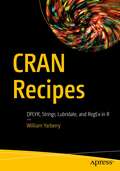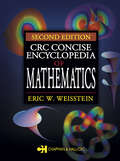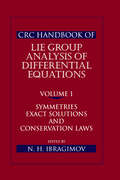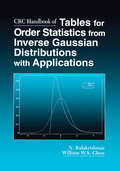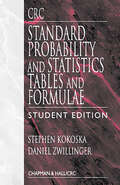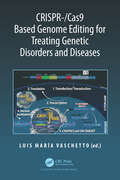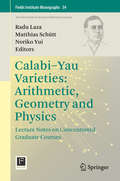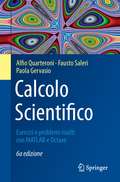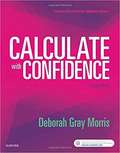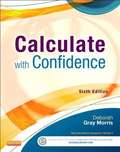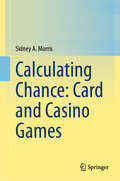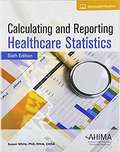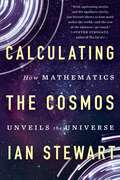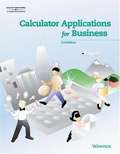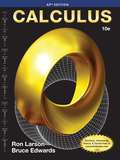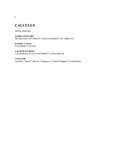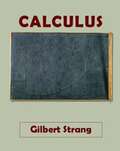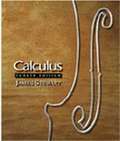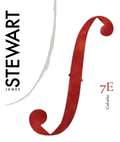- Table View
- List View
CRAN Recipes: DPLYR, Stringr, Lubridate, and RegEx in R
by William YarberryWant to use the power of R sooner rather than later? Don’t have time to plow through wordy texts and online manuals? Use this book for quick, simple code to get your projects up and running. It includes code and examples applicable to many disciplines. Written in everyday language with a minimum of complexity, each chapter provides the building blocks you need to fit R’s astounding capabilities to your analytics, reporting, and visualization needs. CRAN Recipes recognizes how needless jargon and complexity get in your way. Busy professionals need simple examples and intuitive descriptions; side trips and meandering philosophical discussions are left for other books. Here R scripts are condensed, to the extent possible, to copy-paste-run format. Chapters and examples are structured to purpose rather than particular functions (e.g., “dirty data cleanup” rather than the R package name “janitor”). Everyday language eliminates the need to know functions/packages in advance. What You Will LearnCarry out input/output; visualizations; data munging; manipulations at the group level; and quick data explorationHandle forecasting (multivariate, time series, logistic regression, Facebook’s Prophet, and others)Use text analytics; sampling; financial analysis; and advanced pattern matching (regex)Manipulate data using DPLYR: filter, sort, summarize, add new fields to datasets, and apply powerful IF functionsCreate combinations or subsets of files using joinsWrite efficient code using pipes to eliminate intermediate steps (MAGRITTR) Work with string/character manipulation of all types (STRINGR)Discover counts, patterns, and how to locate whole wordsDo wild-card matching, extraction, and invert-matchWork with dates using LUBRIDATEFix dirty data; attractive formatting; bad habits to avoid Who This Book Is For Programmers/data scientists with at least some prior exposure to R.
CRC Concise Encyclopedia of Mathematics
by Eric W. WeissteinUpon publication, the first edition of the CRCConcise Encyclopedia of Mathematics received overwhelming accolades for its unparalleled scope, readability, and utility. It soon took its place among the top selling books in the history of Chapman & Hall/CRC, and its popularity continues unabated.Yet also unabated has been the d
CRC Handbook of Lie Group Analysis of Differential Equations, Volume I: Symmetries, Exact Solutions, and Conservation Laws
by Nail H. IbragimovToday Lie group theoretical approach to differential equations has been extended to new situations and has become applicable to the majority of equations that frequently occur in applied sciences. Newly developed theoretical and computational methods are awaiting application. Students and applied scientists are expected to understand these methods. Volume 3 and the accompanying software allow readers to extend their knowledge of computational algebra.Written by the world's leading experts in the field, this up-to-date sourcebook covers topics such as Lie-Bäcklund, conditional and non-classical symmetries, approximate symmetry groups for equations with a small parameter, group analysis of differential equations with distributions, integro-differential equations, recursions, and symbolic software packages. The text provides an ideal introduction to the modern group analysis and addresses issues to both beginners and experienced researchers in the application of Lie group methods.
CRC Handbook of Lie Group Analysis of Differential Equations, Volume III
by Nail H. IbragimovToday Lie group theoretical approach to differential equations has been extended to new situations and has become applicable to the majority of equations that frequently occur in applied sciences. Newly developed theoretical and computational methods are awaiting application. Students and applied scientists are expected to understand these methods. Volume 3 and the accompanying software allow readers to extend their knowledge of computational algebra.Written by the world's leading experts in the field, this up-to-date sourcebook covers topics such as Lie-Bäcklund, conditional and non-classical symmetries, approximate symmetry groups for equations with a small parameter, group analysis of differential equations with distributions, integro-differential equations, recursions, and symbolic software packages. The text provides an ideal introduction to modern group analysis and addresses issues to both beginners and experienced researchers in the application of Lie group methods.
CRC Handbook of Tables for Order Statistics from Inverse Gaussian Distributions with Applications
by N. Balakrishnan William ChenFirst derived within the context of life-testing, inverse Gaussian distribution has become one of the most important and widely employed distributions, and is often used to model the lifetimes of components. It is also used as a model in many varied applications, including fatigue analysis, economic prediction analysis, and the analysis of extreme events such as rainfall and flood levels. The interesting features and properties of this distribution make it an important and realistic model in a variety of problems across numerous disciplines.Because of the broad range of applications, this handbook will be useful not only to members of the statistical community but will also appeal to applied scientists, engineers, econometricians, and anyone who desires a thorough evaluation of this important topic.
CRC Standard Curves and Surfaces with Mathematica (Advances in Applied Mathematics)
by David H. von SeggernSince the publication of this book’s bestselling predecessor, Mathematica® has matured considerably and the computing power of desktop computers has increased greatly. The Mathematica® typesetting functionality has also become sufficiently robust that the final copy for this edition could be transformed directly from Mathematica R notebooks to LaTex input.Incorporating these aspects, CRC Standard Curves and Surfaces with Mathematica®, Third Edition is a virtual encyclopedia of curves and functions that depicts nearly all of the standard mathematical functions and geometrical figures in use today. The overall format of the book is largely unchanged from the previous edition, with function definitions and their illustrations presented closely together.New to the Third Edition:A new chapter on Laplace transformsNew curves and surfaces in almost every chapterSeveral chapters that have been reorganizedBetter graphical representations for curves and surfaces throughoutDownloadable resources, including the entire book in a set of interactive CDF (Computable Document Format) filesThe book presents a comprehensive collection of nearly 1,000 illustrations of curves and surfaces often used or encountered in mathematics, graphics design, science, and engineering fields. One significant change with this edition is that, instead of presenting a range of realizations for most functions, this edition presents only one curve associated with each function. The graphic output of the Manipulate function is shown exactly as rendered in Mathematica, with the exact parameters of the curve’s equation shown as part of the graphic display. This enables readers to gauge what a reasonable range of parameters might be while seeing the result of one particular choice of parameters.
CRC Standard Probability and Statistics Tables and Formulae, Student Edition
by Stephen Kokoska Daniel ZwillingerUsers of statistics in their professional lives along with statistics students will welcome the CRC Standard Probability and Statistics Tables and Formulae, a concise, easy-to-use reference for basic statistics and probability. It contains all of the standardized statistical tables and formulae typically needed plus material on basic statistics topics, such as probability theory and distributions, regression, analysis of variance, nonparametric statistics, and statistical quality control. With this handy reference, readers can shift their focus from rote learning and memorization to the concepts they need to use statistics efficiently and effectively.
CRISPR-/Cas9 Based Genome Editing for Treating Genetic Disorders and Diseases
by Luis María VaschettoThe CRISPR-Cas9 genome-editing system is creating a revolution in the science world. In the laboratory, CRISPR-Cas9 can efficiently be used to target specific genes, correct mutations and regulate gene expression of a wide array of cells and organisms, including human cells. CRISPR-/Cas9 Based Genome Editing for Treating Genetic Disorders and Diseases is a unique reading material for college students, academicians, and other health professionals interested in learning about the broad range of applications of CRISPR/Cas9 genetic scissors. Some topics included in this book are: the role of the CRISPR/Cas9 system in neuroscience, gene therapy, epigenome editing, genome mapping, cancer, virus infection control strategies, regulatory challenges and bioethical considerations.
Cake-Cutting Algorithms: Be Fair if You Can
by Jack Robertson William WebbThe challenge of dividing an asset fairly, from cakes to more important properties, is of great practical importance in many situations. Since the famous Polish school of mathematicians (Steinhaus, Banach, and Knaster) introduced and described algorithms for the fair division problem in the 1940s, the concept has been widely popularized. This book
Calabi-Yau Varieties: Lecture Notes on Concentrated Graduate Courses (Fields Institute Monographs #34)
by Matthias Schütt Radu Laza Noriko YuiThis volume presents a lively introduction to the rapidly developing and vast research areas surrounding Calabi-Yau varieties and string theory. With its coverage of the various perspectives of a wide area of topics such as Hodge theory, Gross-Siebert program, moduli problems, toric approach, and arithmetic aspects, the book gives a comprehensive overview of the current streams of mathematical research in the area. The contributions in this book are based on lectures that took place during workshops with the following thematic titles: "Modular Forms Around String Theory," "Enumerative Geometry and Calabi-Yau Varieties," "Physics Around Mirror Symmetry," "Hodge Theory in String Theory. " The book is ideal for graduate students and researchers learning about Calabi-Yau varieties as well as physics students and string theorists who wish to learn the mathematics behind these varieties.
Calcolo Scientifico: Esercizi e problemi risolti con MATLAB e Octave (UNITEXT #105)
by Alfio Quarteroni Fausto Saleri Paola GervasioQuesto testo #65533; concepito per i corsi delle Facolt#65533; di Ingegneria e di Scienze. Esso affronta tutti gli argomenti tipici della Matematica Numerica, spaziando dal problema di risolvere sistemi di equazioni lineari e non lineari a quello di approssimare una funzione, di calcolare i suoi minimi, le sue derivate ed il suo integrale definito fino alla risoluzione di equazioni differenziali ordinarie e alle derivate parziali con metodi alle differenze finite ed agli elementi finiti. Un capitolo iniziale conduce lo studente ad un rapido ripasso degli argomenti dell'Analisi Matematica e dell'Algebra Lineare di uso frequente nel volume e ad una introduzione ai linguaggi MATLAB e Octave. Al fine di rendere maggiormente incisiva la presentazione e fornire un riscontro quantitativo immediato alla teoria vengono implementati in linguaggio MATLAB e Octave tutti gli algoritmi che via via si introducono. Vengono inoltre proposti numerosi esercizi, tutti risolti per esteso, ed esempi, anche con riferimento ad applicazioni in vari ambiti scientifici. Questa sesta edizione si differenzia dalle precedenti per l'aggiunta di nuovi sviluppi, di nuovi esempi relativi ad applicazioni di interesse reale e di svariati esercizi con relative soluzioni.
Calculate With Confidence
by Deborah Gray MorrisLearn the three major methods of drug calculation! Calculate with Confidence, 7th Edition focuses on the increasing responsibility of the nurse in medication administration, prioritizes client safety with QSEN, and includes updated content that reflects the current scope of practice. This popular text covers the ratio and proportion, formula, and dimensional analysis methods offering a step-by-step approach to the calculation and administration of drug dosages. With over 2,100 practice problems, this comprehensive title focuses on enhancing the learning experience of nursing students at all curricular levels by making content clinically applicable.
Calculate with Confidence (Sixth Edition)
by Deborah Gray MorrisCalculate with Confidence, 6th Edition addresses the increasing responsibility of the nurse in medication administration, prioritizes client safety, and reflects the current scope of practice. This text covers the ratio and proportion, formula, and dimensional analysis methods offering a step-by-step approach to the calculation and administration of drug dosages. With over 2,000 practice problems, Gray Morris focuses on enhancing the learning experience of nursing students at all curricular levels by making content clinically applicable.
Calculated Risks: How to Know When Numbers Deceive You
by Gerd GigerenzerAt the beginning of the twentieth century, H. G. Wells predicted that statistical thinking would be as necessary for citizenship in a technological world as the ability to read and write. But in the twenty-first century, we are often overwhelmed by a baffling array of percentages and probabilities as we try to navigate in a world dominated by statistics.Cognitive scientist Gerd Gigerenzer says that because we haven't learned statistical thinking, we don't understand risk and uncertainty. In order to assess risk -- everything from the risk of an automobile accident to the certainty or uncertainty of some common medical screening tests -- we need a basic understanding of statistics.Astonishingly, doctors and lawyers don't understand risk any better than anyone else. Gigerenzer reports a study in which doctors were told the results of breast cancer screenings and then were asked to explain the risks of contracting breast cancer to a woman who received a positive result from a screening. The actual risk was small because the test gives many false positives. But nearly every physician in the study overstated the risk. Yet many people will have to make important health decisions based on such information and the interpretation of that information by their doctors.Gigerenzer explains that a major obstacle to our understanding of numbers is that we live with an illusion of certainty. Many of us believe that HIV tests, DNA fingerprinting, and the growing number of genetic tests are absolutely certain. But even DNA evidence can produce spurious matches. We cling to our illusion of certainty because the medical industry, insurance companies, investment advisers, and election campaigns have become purveyors of certainty, marketing it like a commodity.To avoid confusion, says Gigerenzer, we should rely on more understandable representations of risk, such as absolute risks. For example, it is said that a mammography screening reduces the risk of breast cancer by 25 percent. But in absolute risks, that means that out of every 1,000 women who do not participate in screening, 4 will die; while out of 1,000 women who do, 3 will die. A 25 percent risk reduction sounds much more significant than a benefit that 1 out of 1,000 women will reap.This eye-opening book explains how we can overcome our ignorance of numbers and better understand the risks we may be taking with our money, our health, and our lives.
Calculating Chance: Card and Casino Games
by Sidney A. MorrisThis book offers a gentle yet rigorous introduction to probability theory, with a special focus on finite probability spaces. Drawing inspiration from card games, casino games, mahjong, and two-up, it also delves into real-world applications such as weather forecasting, lotteries, hereditary diseases, and PCR virus testing. Discover which casino game gives you the best chance of winning and which one offers the worst odds. Assuming only a high school mathematics background, this book is an excellent resource for both students and teachers, providing clear explanations and engaging examples. The technical material is lightened with entertaining stories, such as how someone became a millionaire by spotting a flaw in a national lottery and how another person helped fund a war using winnings from a well-known card game he invented. Engaging and informative, this book is perfect for anyone looking to deepen their understanding of probability theory while enjoying some fascinating anecdotes along the way.
Calculating Dosages Safely: A Dimensional Analysis Approach
by Tracy HorntvedtDosage calculations can be intimidating, but they don't need to be. Using dimensional analysis, you'll learn how to calculate both simple and complex medication dosage problems with consistency and accuracy and reduce medication errors with simple safety mechanisms. This reliable and consistent method helps to ensure safe medication administration practices. Dimensional analysis, which can be used on virtually every dosage calculation problem, eliminates the need to use other methods or perform lengthy, multi-step calculations. It's a method of problem-solving that organizes data in a manner that is easy to understand and apply.
Calculating and Reporting Healthcare Statistics
by Susan WhiteCalculating and Reporting Healthcare Statistics, sixth edition, is a comprehensive resource intended for healthcare professionals and students seeking to understand or sharpen their statistical computation skills. The text is organized around exercises and examples that are presented extensively using Excel calculation displays. <p><p> Susan White, PhD, RHIA, CHDA,brings her expertise in the area of analyzing healthcare data to this valuable reference. Topics are updated to explore the current healthcare industry, basic math and statistical computations, vital statistics and mortality rates, census and occupancy rates, and more, all in accordance with AHIMA curriculum domains for statistics.
Calculating the Cosmos: How Mathematics Unveils the Universe
by Ian StewartA prize-winning popular science writer uses mathematical modeling to explain the cosmos.In Calculating the Cosmos, Ian Stewart presents an exhilarating guide to the cosmos, from our solar system to the entire universe. He describes the architecture of space and time, dark matter and dark energy, how galaxies form, why stars implode, how everything began, and how it's all going to end. He considers parallel universes, the fine-tuning of the cosmos for life, what forms extraterrestrial life might take, and the likelihood of life on Earth being snuffed out by an asteroid.Beginning with the Babylonian integration of mathematics into the study of astronomy and cosmology, Stewart traces the evolution of our understanding of the cosmos: How Kepler's laws of planetary motion led Newton to formulate his theory of gravity. How, two centuries later, tiny irregularities in the motion of Mars inspired Einstein to devise his general theory of relativity. How, eighty years ago, the discovery that the universe is expanding led to the development of the Big Bang theory of its origins. How single-point origin and expansion led cosmologists to theorize new components of the universe, such as inflation, dark matter, and dark energy. But does inflation explain the structure of today's universe? Does dark matter actually exist? Could a scientific revolution that will challenge the long-held scientific orthodoxy and once again transform our understanding of the universe be on the way? In an exciting and engaging style, Calculating the Cosmos is a mathematical quest through the intricate realms of astronomy and cosmology.
Calculator Applications for Business (3rd edition)
by Sandra YelvertonCALCULATOR APPLICATIONS FOR BUSINESS provides students realistic experience with business applications typically performed on electronic calculators or other office machine keypads. Students learn to manage their time, become familiar with business forms, develop accuracy in machine operation, expand and refine math skills, and explore career opportunities.
Calculus
by Ron Larson Bruce EdwardsThe Larson CALCULUS program has a long history of innovation in the calculus market. It has been widely praised by a generation of students and professors for its solid and effective pedagogy that addresses the needs of a broad range of teaching and learning styles and environments. Each title is just one component in a comprehensive calculus course program that carefully integrates and coordinates print, media, and technology products for successful teaching and learning.
Calculus
by Ron Larson Bruce EdwardsThis edition clearly presents and effectively demonstrates the concepts and rules of calculus using a thoroughly updated learning experience specifically designed to remove any typical barriers to learning. New "Big Ideas of Calculus" notes present the overarching ideas behind chapter topics, while annotated examples and "Concept Checks" further reinforce your understanding. Step-by-step solution videos, exercise solutions and other tutorial support are available at no cost from CalcView.com, CalcChat.com and LarsonCalculus.com. In addition, new automatically graded Proof Problems with instant feedback, Expanded Problems and "Explore It" interactive learning modules within WebAssign digital resources help you develop a deeper conceptual understanding of calculus to succeed in this course and beyond.
Calculus
by James Stewart Saleem Watson Daniel K. CleggJames Stewart's Calculus series is the top-seller in the world because of its problem-solving focus, mathematical precision and accuracy, and outstanding examples and problem sets. <p><p> Selected and mentored by Stewart, Daniel Clegg and Saleem Watson continue his legacy of providing students with the strongest foundation for a STEM future. Their careful refinements retain Stewart’s clarity of exposition and make the 9th Edition even more useful as a teaching tool for instructors and as a learning tool for students. Showing that Calculus is both practical and beautiful, the Stewart approach enhances understanding and builds confidence for millions of students worldwide.
Calculus
by Gilbert StrangGilbert Strang's clear, direct style and detailed, intensive explanations make this textbook ideal as both a course companion and for self-study. <p><p>Single variable and multivariable calculus are covered in depth. Key examples of the application of calculus to areas such as physics, engineering and economics are included in order to enhance students' understanding. <p><p>New to the third edition is a chapter on the 'Highlights of calculus', which accompanies the popular video lectures by the author on MIT's OpenCourseWare. These can be accessed from math.mit.edu/~gs.
Calculus
by James StewartSuccess in your calculus course starts here! James Stewart's CALCULUS texts are world-wide best-sellers for a reason: they are clear, accurate, and filled with relevant, real-world examples. With CALCULUS, Seventh Edition, Stewart conveys not only the utility of calculus to help you develop technical competence, but also gives you an appreciation for the intrinsic beauty of the subject. His patient examples and built-in learning aids will help you build your mathematical confidence and achieve your goals in the course!
